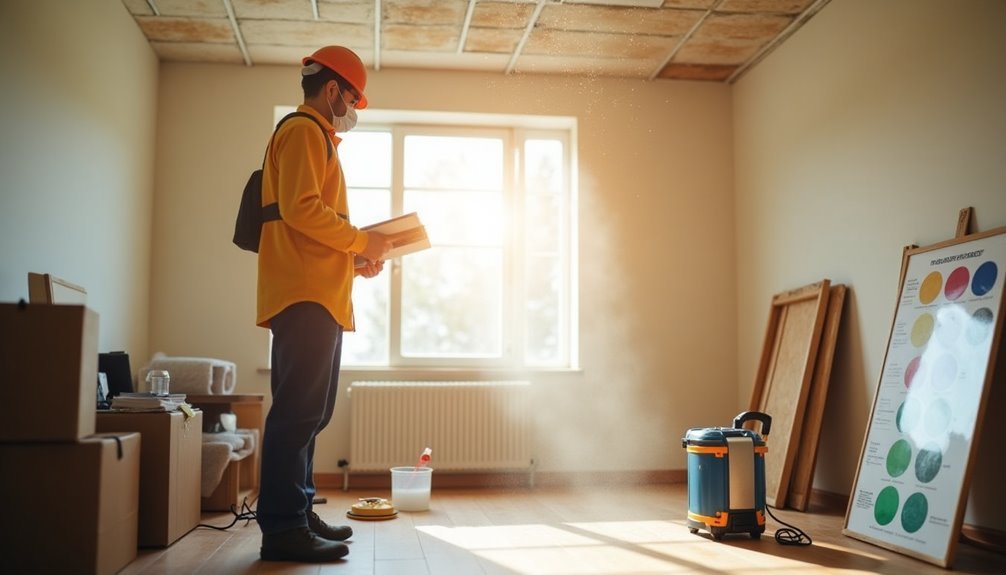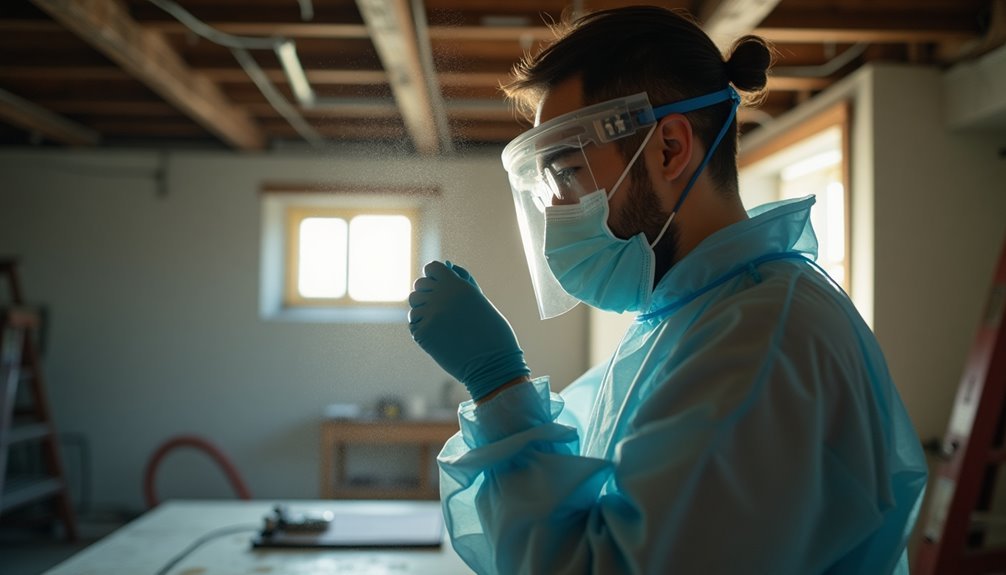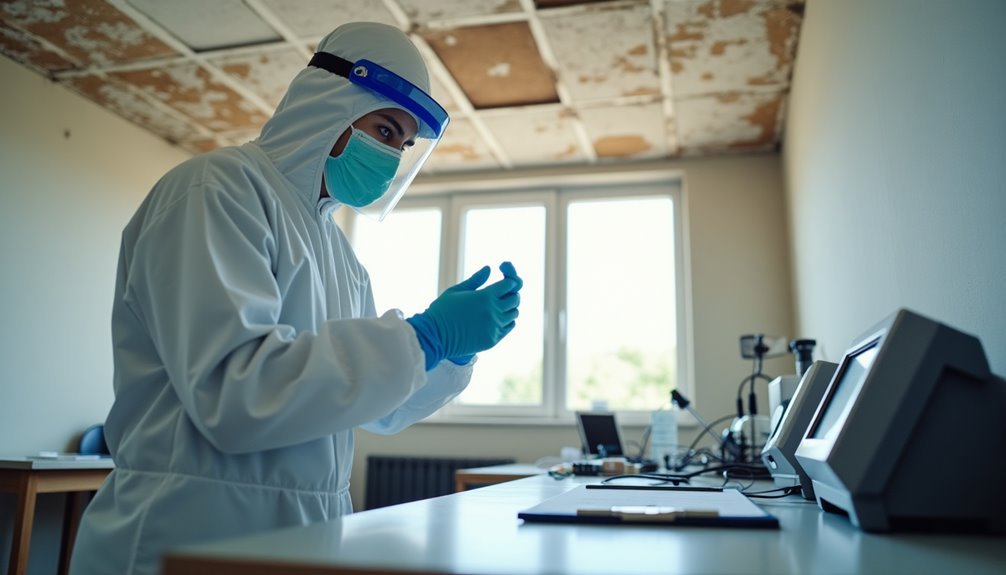During asbestos testing, you'll first conduct a historical review of your home to identify potential asbestos-containing materials (ACMs). Next, a professional will perform a visual inspection for damage, ensuring HVAC systems are shut down to prevent fiber spread. They'll collect small samples while wearing protective gear to minimize exposure. These samples are then sent to a lab for analysis using methods like Polarized Light Microscopy. Once results are received, you'll receive a detailed report outlining the findings and necessary actions. Understanding this process is vital for your safety and compliance; there's more essential information to consider.
Initial Assessment Process

During the initial assessment process, it's crucial to conduct a thorough historical review and research to pinpoint potential asbestos-containing materials (ACMs) within the building. You'll begin by examining building records and historical documents to uncover any information about construction dates and materials commonly used during that era. This step highlights the historical significance of the building, which can help identify areas likely to contain ACMs.
Next, analyze previous inspections or renovations, and consult with current and former occupants or maintenance personnel. Their insights about past repairs or health concerns related to asbestos exposure can be invaluable for understanding potential risks. Additionally, it's important to recognize that asbestos is a group of naturally occurring fibrous minerals that were widely used in construction, which can further guide your investigation.
You'll also conduct interviews to gather detailed information on construction materials and suppliers, focusing on any significant changes over the years. All this data is essential for ensuring regulatory compliance and forms the backbone of your inspection plan.
Finally, compile this information into a comprehensive report that outlines the initial assessment findings. By prioritizing areas for further investigation, you set the stage for a more detailed examination, safeguarding both your property and your health in the process.
Conducting a Physical Inspection
When you conduct a physical inspection for asbestos, a meticulous approach is essential to ensure all potential sources of asbestos-containing materials (ACMs) are identified. Start with a thorough visual examination of building materials, looking for indicators like torn, frayed, or water-damaged surfaces. Pay special attention to areas that experience frequent disturbance, as these are more likely to release asbestos fibers.
Next, assess the material conditions by testing for friability, which indicates how easily materials can crumble and release fibers. Check for wear and tear, including abrasions, and consider how environmental factors like moisture or temperature changes may affect material stability.
Focus on specific areas known for asbestos use, such as roofing, siding, insulation, and flooring. Don't overlook HVAC systems and common household items like furnaces or stovetops. Document your findings meticulously, noting the presence, absence, and condition of ACMs. This documentation is crucial for regulatory compliance with regulations like AHERA and will guide future actions, whether they involve repair, encapsulation, or removal of hazardous materials.
Sample Collection Techniques

To ensure effective asbestos sampling, it's crucial to follow established techniques that minimize the risk of exposure and contamination. Proper sample handling and containment methods are essential for safety and accuracy. Here's how to collect samples safely:
- Shut down HVAC systems: This prevents the spread of asbestos fibers through your ventilation.
- Wet the area: Dampening the material reduces airborne fibers during sample collection.
- Use protective gear: Always wear gloves, a mask, and coveralls to protect yourself from exposure.
- Minimize sample size: Collect small samples to limit disturbance of potentially hazardous materials.
When sampling different materials, use the appropriate tools like a small clean knife for cutting and Ziploc bags for storage. For drywall joint compound, sample both layers, and for vermiculite, take samples from various depths. After collecting samples, seal them tightly, label them clearly, and document your process thoroughly.
Lastly, clean the area to eliminate any potential dust. Following these steps ensures that you handle asbestos safely and effectively, preserving your health while you address your home's needs.
Laboratory Analysis Methods
Laboratory analysis methods play a crucial role in accurately identifying and quantifying asbestos fibers in collected samples. Understanding these asbestos identification techniques is essential to ensure safety during testing. Various methodologies are employed, each with specific strengths and limitations, while adhering to strict laboratory safety protocols.
| Method | Key Features | Use Cases |
|---|---|---|
| Polarized Light Microscopy | Identifies bulk samples; qualitative analysis | Initial identification of asbestos |
| Transmission Electron Microscopy | Higher magnification; detects fine fibers | Detailed analysis of air samples |
| Phase Contrast Microscopy | Monitors airborne asbestos; workplace compliance | Assessing workplace exposure |
Polarized Light Microscopy (PLM) serves as the primary method for bulk samples, distinguishing fibers by their optical properties. Transmission Electron Microscopy (TEM) is crucial for air samples, detecting fibers thinner than 0.25 µm. Stereomicroscopy provides a preliminary analysis by examining the physical properties of samples, while Phase Contrast Microscopy (PCM) monitors airborne asbestos particles. Each method requires compliance with laboratory safety protocols to ensure accurate, reliable results in asbestos testing.
Understanding the Report

When you receive your asbestos testing report, you'll find essential components that detail the results and their implications. The report includes your property's specifics, sample descriptions, and any detected asbestos percentages, which are crucial for understanding the findings. Accurately interpreting these results will guide your next steps in ensuring a safe environment.
Key Report Components
A comprehensive understanding of the key report components is essential for effectively interpreting asbestos testing results. Familiarizing yourself with these elements not only enhances your awareness but also empowers you to make informed decisions regarding asbestos management. Here are the critical report components you should focus on:
- Survey Details and Methodology: This includes the facility's address, type of survey conducted, and purpose.
- Findings and Asbestos Register: A summary of findings, including the presence, location, and condition of asbestos-containing materials (ACMs), is crucial. The asbestos register details these aspects.
- Recommendations and Actions: The report should provide guidance on managing ACMs, including removal or monitoring strategies.
- Documentation and Accreditation: Look for laboratory results and site plans, ensuring they come from accredited sources.
Understanding these report components ensures you grasp the implications of the findings fully. With this knowledge, you can confidently navigate the next steps in managing asbestos risks in your property, ultimately liberating yourself from potential hazards.
Interpreting Test Results
Interpreting test results is crucial for understanding the presence and implications of asbestos in your property. Your report will detail any asbestos types detected, such as chrysotile, amosite, or crocidolite, along with their percentage composition. If concentrations exceed the detection limit, immediate action may be necessary. Conversely, results showing "less than 0.1%" indicate no significant presence, offering peace of mind.
Concentration levels are vital for gauging the severity of contamination. Low levels might call for minimal intervention, while high concentrations require urgent abatement measures. The report often employs a 1000 point count method in PLM analysis to determine these levels accurately. Additionally, it may provide safety guidelines for interpreting these results.
Be aware of potential false positives or negatives, which might arise from sampling errors or uneven asbestos distribution. If your initial results indicate no asbestos but you suspect otherwise, consider further analysis using Transmission Electron Microscopy (TEM).
Ultimately, if asbestos is detected, consult with certified professionals to create an effective abatement plan. Understanding your test results empowers you to take informed action, ensuring your safety and that of your loved ones.
Post-Inspection Recommendations
After your inspection, it's crucial to implement safe handling practices for any identified asbestos materials. If removal is necessary, you'll need to engage professional removal services that comply with safety regulations and standards. Following these steps ensures a safer environment and minimizes health risks associated with asbestos exposure.
Safe Handling Practices
It's essential to implement safe handling practices following an asbestos inspection to ensure continued safety and compliance. Adhering to asbestos regulations and conducting safety training for all involved can significantly reduce risks. Here are four key practices to follow:
- Visual Inspection: Regularly check areas with asbestos-containing materials (ACMs) for signs of damage or deterioration. Document your findings for future reference.
- Sample Containment: If you suspect asbestos presence, collect samples carefully using containment measures. Seal the area with plastic sheeting to prevent fiber release.
- Use of PPE: Always wear appropriate personal protective equipment (PPE), including respirators and disposable coveralls. Ensure that anyone nearby is also protected from potential exposure.
- Update Management Plan: Continuously monitor the condition of ACMs and update your asbestos management plan. Schedule periodic re-inspections to stay compliant with regulations.
Professional Removal Services
When dealing with asbestos post-inspection, engaging professional removal services is crucial for ensuring safety and compliance with regulations. A detailed asbestos abatement plan is essential, outlining the scope of work, expected duration, and methods for removal or encapsulation. This plan must adhere to local, state, and federal asbestos regulations to protect your home and health.
It's vital to hire licensed asbestos removal contractors. These professionals possess the necessary contractor qualifications, ensuring they are trained to handle hazardous materials safely. Look for contractors certified by relevant authorities, such as the EPA, and ensure they carry comprehensive insurance. Their experience and reputation can significantly influence the quality of the service you receive.
Depending on the state of the asbestos-containing materials (ACM), your contractor might recommend complete removal or encapsulation. Encapsulation can often be a safer choice, preventing fiber release while maintaining structural integrity. After the abatement process, a third-party inspector should conduct a post-removal verification to confirm safety. This step ensures compliance with all regulations, issuing a final clearance certificate if your property is deemed safe. By following these guidelines, you can liberate your space from the threats posed by asbestos.
Safety Measures to Follow

Implementing effective safety measures is crucial when dealing with asbestos testing to minimize health risks. Proper precautions ensure contamination prevention and protect everyone involved.
Here are key safety measures to follow:
- Secure the Area: Isolate the testing area by sealing it off from the rest of your property. Shut down HVAC systems and cover vents to prevent asbestos fibers from spreading.
- Use Personal Protective Equipment (PPE): Wear appropriate safety equipment such as disposable clothing, gloves, and respirators. Ensure your PPE is made of synthetic materials to block fiber penetration.
- Sample Taking Safety: Wet asbestos materials with a fine mist of water to reduce fiber release before sampling. Use specialized tools to obtain a small sample while minimizing disturbance to the material.
- Clean Up and Decontamination: After sampling, carefully clean the area using wet methods. Dispose of or properly clean all protective clothing, and ensure the sample container is airtight and labeled.
Conclusion
In the end, navigating asbestos testing is like walking a tightrope between safety and risk. You've assessed your home, collected samples, and analyzed the results, all while keeping your family's health in mind. Understanding the report empowers you to make informed decisions, whether it's remediation or simple maintenance. By following post-inspection recommendations and adhering to safety measures, you transform uncertainty into peace of mind, ensuring your home remains a sanctuary rather than a source of concern.
